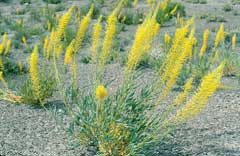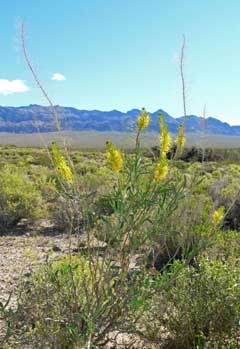 |
|
www.ars.usda.gov |
 |
| http://commons.wikimedia.org/wiki/User:Stan_Shebs |
Translate this page:
Summary
Physical Characteristics

 Stanleya pinnata is a PERENNIAL growing to 1 m (3ft 3in) by 0.5 m (1ft 8in).
Stanleya pinnata is a PERENNIAL growing to 1 m (3ft 3in) by 0.5 m (1ft 8in).
See above for USDA hardiness. It is hardy to UK zone 7. It is in flower from July to September. The species is hermaphrodite (has both male and female organs) and is pollinated by Insects.
Suitable for: light (sandy) and medium (loamy) soils, prefers well-drained soil and can grow in nutritionally poor soil. Suitable pH: mildly acid, neutral and basic (mildly alkaline) soils. It cannot grow in the shade. It prefers dry or moist soil.
UK Hardiness Map
US Hardiness Map
Synonyms
S. pinnatifida. Nutt.
Plant Habitats
Cultivated Beds;
Edible Uses
Edible Parts: Leaves Seed
Edible Uses:
Seed - cooked. It is used as a piñole[105, 161]. The seed can be parched, ground into a powder and used as a mush[183]. Young leaves and stems - cooked[46, 61, 95, 161]. A cabbage-like flavour, they can be quite bitter at first but changing the water once or more whilst cooking removes the bitterness[183, 257]. Used in the spring[216]. Changing the water also removes many of the vitamins and minerals[K].
References More on Edible Uses
Medicinal Uses
Plants For A Future can not take any responsibility for any adverse effects from the use of plants. Always seek advice from a professional before using a plant medicinally.
Antipruritic Odontalgic Poultice Tonic VD
A decoction of the root has been used as a tonic to treat general debility after an illness[257]. The pulped root can be placed on the gum or in a tooth cavity in order to relieve toothache[207, 257]. It can also be applied externally as a poultice to relieve earache and rheumatic pain[207, 257]. A poultice of the mashed root has been applied to the throat to treat throat pain and is also used to treat the congestion of diphtheria[257]. A poultice of the plant has been applied to glandular swellings[257]. The powdered plant has been applied as a specific to scraped syphilitic sores[257]. A poultice of the freshly chewed seedpods has been used to treat itches[257].
References More on Medicinal Uses
The Bookshop: Edible Plant Books
Our Latest books on Perennial Plants For Food Forests and Permaculture Gardens in paperback or digital formats.

Edible Tropical Plants
Food Forest Plants for Hotter Conditions: 250+ Plants For Tropical Food Forests & Permaculture Gardens.
More

Edible Temperate Plants
Plants for Your Food Forest: 500 Plants for Temperate Food Forests & Permaculture Gardens.
More

More Books
PFAF have eight books available in paperback and digital formats. Browse the shop for more information.
Shop Now
Other Uses
References More on Other Uses
Cultivation details
Requires a perfectly drained soil in full sun[200]. Grows well in an ordinary garden soil[1]. Prefers a poor dry soil[187]. Hardy to about -20°c[187]. Grows well at Kew in a warm sunny well-drained border[K]. There is some confusion over the correct name of this plant, 2 different spellings having been used. Whilst it is possible that these are 2 different plants, it is more likely that the name used at the top of this form is the correct one, whilst the name in the synonyms list is a mis-spelling[161, K]. The plant is often found growing in soils rich in selenium and is a fairly good indicator that selenium is present[200].
References Carbon Farming Information and Carbon Sequestration Information
Temperature Converter
Type a value in the Celsius field to convert the value to Fahrenheit:
Fahrenheit:
The PFAF Bookshop
Plants For A Future have a number of books available in paperback and digital form. Book titles include Edible Plants, Edible Perennials, Edible Trees,Edible Shrubs, Woodland Gardening, and Temperate Food Forest Plants. Our new book is Food Forest Plants For Hotter Conditions (Tropical and Sub-Tropical).
Shop Now
Plant Propagation
Seed - sow spring in a greenhouse. Germination should take place within 3 weeks. Pot up into individual pots as soon as the plants are big enough to handle in order to preserve the root system. Plant out in summer. Division in spring?
Other Names
If available other names are mentioned here
Native Range
NORTHERN AMERICA: United States (Kansas (west), Nebraska (northwest), North Dakota (west), South Dakota (west), Colorado, Idaho, Montana, Oregon (southeast), Wyoming, New Mexico, Texas, Arizona, California, Nevada, Utah)
Weed Potential
Right plant wrong place. We are currently updating this section.
Please note that a plant may be invasive in one area but may not in your area so it's worth checking.
Conservation Status
IUCN Red List of Threatened Plants Status :

Growth: S = slow M = medium F = fast. Soil: L = light (sandy) M = medium H = heavy (clay). pH: A = acid N = neutral B = basic (alkaline). Shade: F = full shade S = semi-shade N = no shade. Moisture: D = dry M = Moist We = wet Wa = water.
Now available:
Food Forest Plants for Mediterranean Conditions
350+ Perennial Plants For Mediterranean and Drier Food Forests and Permaculture Gardens.
[Paperback and eBook]
This is the third in Plants For A Future's series of plant guides for food forests tailored to
specific climate zones. Following volumes on temperate and tropical ecosystems, this book focuses
on species suited to Mediterranean conditions—regions with hot, dry summers and cool, wet winters,
often facing the added challenge of climate change.
Read More
Expert comment
Author
(Pursh.)Britton.
Botanical References
71200
Links / References
For a list of references used on this page please go here
Readers comment
| Add a comment |
|
If you have important information about this plant that may help other users please add a comment or link below. Only comments or links that are felt to be directly relevant to a plant will be included. If you think a comment/link or information contained on this page is inaccurate or misleading we would welcome your feedback at [email protected]. If you have questions about a plant please use the Forum on this website as we do not have the resources to answer questions ourselves.
* Please note: the comments by website users are not necessarily those held by PFAF and may give misleading or inaccurate information.
To leave a comment please Register or login here All comments need to be approved so will not appear immediately.
|
Subject : Stanleya pinnata
|
|
|
|